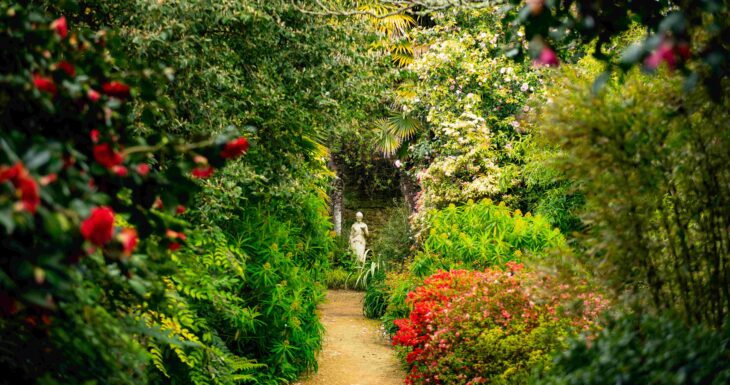Abbotsbury Subtropical Gardens
A subtropical botanical treasure trove of rare and exotic plants on the Dorset Jurassic coast.
Buller's Way, Abbotsbury, Dorset, DT3 4LA

Dogs
Well-behaved dogs are welcome on leads throughout the Garden, as well as outside and inside the coffee shop.
Toilets
Disabled and baby change facilities available at the coffee shop.
Wheelchairs and scooters are not available for hire. If you are a wheelchair user, we recommend you bring an all-terrain, wide-based wheelchair for access around the wheelchair and mobility vehicle route. The paths at the Gardens are gravel and some areas are very steep due to the natural topography. There is a wheelchair and mobility vehicle route, which follows an abbreviated route over gravel paths, some rough terrain and sloping paths. Disabled parking is available in the first row of the main car park 50 metres from the Gardens entrance. Toilets are located for visitors with disabilities to the rear of the coffee shop at the entrance.
The history of Abbotsbury is tied closely with the creation of the monastery that once dominated the village and the Fox-Strangways family.
In 1541, the abbey lands were leased to Sir Giles Strangways, who converted part of the old monastery into a mansion. Later, Sir John Strangways, who was a staunch Royalist, held Abbotsbury for the King until the civil war broke out in 1644.
Defoe, on his tour of England in 1724, said: ‘the mackerel are the finest I ever saw sold at the seaside for a hundred a penny’. The London Journal recorded in 1752 that ‘all the people of Abbotsbury, including the Vicar, are thieves, smugglers and plunderers of wrecks’. Changes were, however, taking place. Susannah Strangways-Horner, mother-in-law of the 1st Earl of Ilchester, left money in her will to found a school in 1758. In 1765 her daughter Elizabeth, 1st Countess of Ilchester, built the castle on a site overlooking Lyme Bay. A wall was built for a sheltered kitchen garden to provide fresh produce for the family in residence. That walled garden is now the very heart of the Abbotsbury Subtropical Gardens that we know today.
The range of plants in the garden was expanded under the auspices of William Fox-Strangways, 4th Earl of Ilchester. He was a diplomat on foreign service, a leading botanist and an expert on the flora of Europe. He introduced many new species into cultivation, from a wide range of countries. He and his successors took the garden into the surrounding woodland, where the shade, shelter and moisture provided ideal conditions for the great influx of newly collected plants from the Himalayas, China and Japan.
The 5th Lord of Ilchester was devoted to the care of this garden as his ancestors were, and he and Lady Ilchester trebled its original size. It became home to one of the finest plant collections in England at the time.In 1899 a catalogue was printed by Lady Ilchester of all the different plants growing in the garden – and the number amounted to over 5,000. This, of course, was constantly being added to.
In 1913 the castle burned down. It was rebuilt in 1915, but due to some major construction faults in remained uninhabited and was eventually demolished in 1934. Today, all that remains is a section of the outer wall, visible from the beach.
The period between the two wars was a time of economic difficulty when labour and resources were scarce, so the gardens were understandably neglected and soon declined beneath a rolling sea of brambles and runaway bamboos. Here, in the gardens, rampant growth and weed species take advantage of lack of vigilance at an astonishing rate.
In the late 1960s, Lady Teresa Agnew and her first husband Lord Galway introduced a programme of restoration. A further 3 acres were added between 1982 and 1984, but a major impact on garden development has been made since the damage from the Great Storm of 1987 and subsequent replanting from 1990 onwards. Lady Teresa died in 1989 and her daughter, the Honourable Charlotte Monckton inherited the Estate and still owns it today. The gardens is of botanical importance but also the unbroken historical ownership by the family since its conception in 1765 by the 1st Countess of Ilchester.
Dogs
Well-behaved dogs are welcome on leads throughout the Garden, as well as outside and inside the coffee shop.
Toilets
Disabled and baby change facilities available at the coffee shop.
Wheelchairs and scooters are not available for hire. If you are a wheelchair user, we recommend you bring an all-terrain, wide-based wheelchair for access around the wheelchair and mobility vehicle route. The paths at the Gardens are gravel and some areas are very steep due to the natural topography. There is a wheelchair and mobility vehicle route, which follows an abbreviated route over gravel paths, some rough terrain and sloping paths. Disabled parking is available in the first row of the main car park 50 metres from the Gardens entrance. Toilets are located for visitors with disabilities to the rear of the coffee shop at the entrance.
